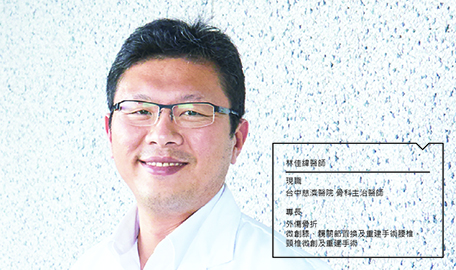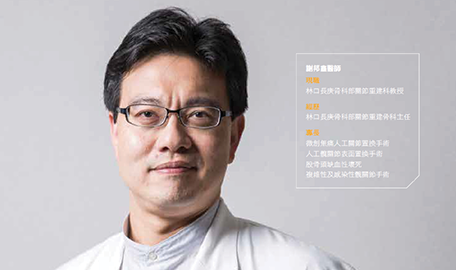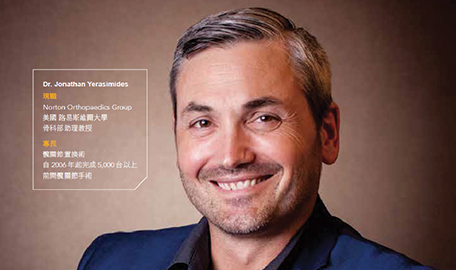台灣捷邁醫療器材股份有限公司
內容
轉子間骨折是高齡化社會中,骨質疏鬆的中老年人最常遇到的骨折類型之一。在本期的S&H,我們請到了新生代的骨創傷專家,高雄市立大同醫院李天慶醫師與我們分享植入物的選擇,以及在轉子間骨折治療中該注意的技巧。
隨著老年社會的到來,骨質疏鬆的病人與日俱增,髖部骨折幾已成為日常的骨科境況。其中轉子間不穩定型骨折(unstable intertrochanter fracture)的固定,對於許多骨科醫師而言,仍是棘手的臨床課題。由於內固定器的發展, (intertrochanter fracture 的固定從早期使用髓外固定器(extramedullary fixation)(如blade-plate, sliding hip-screw, and locking-plate fixation 等)已逐漸偏向採用髓內固定器(intramedullary fixation)。JBJSA 在2008年的文章就指出美國intramedullary fixation 的使用率從1999 年的3% 一路攀升到2006 年的67%(1)。這種情況在筆者所處的高醫體系亦可見一斑。然而這樣的大勢所趨是醫療科技進步使然? 還是廠商、醫院、甚至政策的相互影響所促成? 筆者嘗試單純就臨床分析髓內釘治療轉子間不穩定型骨折的優劣,以期提供骨科同好們日後選擇的參考。
髓內釘應用在intertrochanter fracture 的生物力學優勢包括能有效地將femoral head 的承重轉移至medial calcar、其髓內的解剖位置因較為接近mechanical axis,能減少骨折移位的力矩和應變量(2)。手術過程中相較於髓外固定能減少軟組織的破壞(3),亦有文獻指出可減少手術時間、輸血需求、住院天數、術後腿不等長的風險、及較佳的術後活動能力(4, 5)。更重要的是面對不穩定的骨折型態,如compromise of the posteromedial or the lateral cortex、subtrochanteric extension 和reversed obliquity 等情況時能提供較可信賴的固定效果(1, 3-5)(如圖1)。
圖1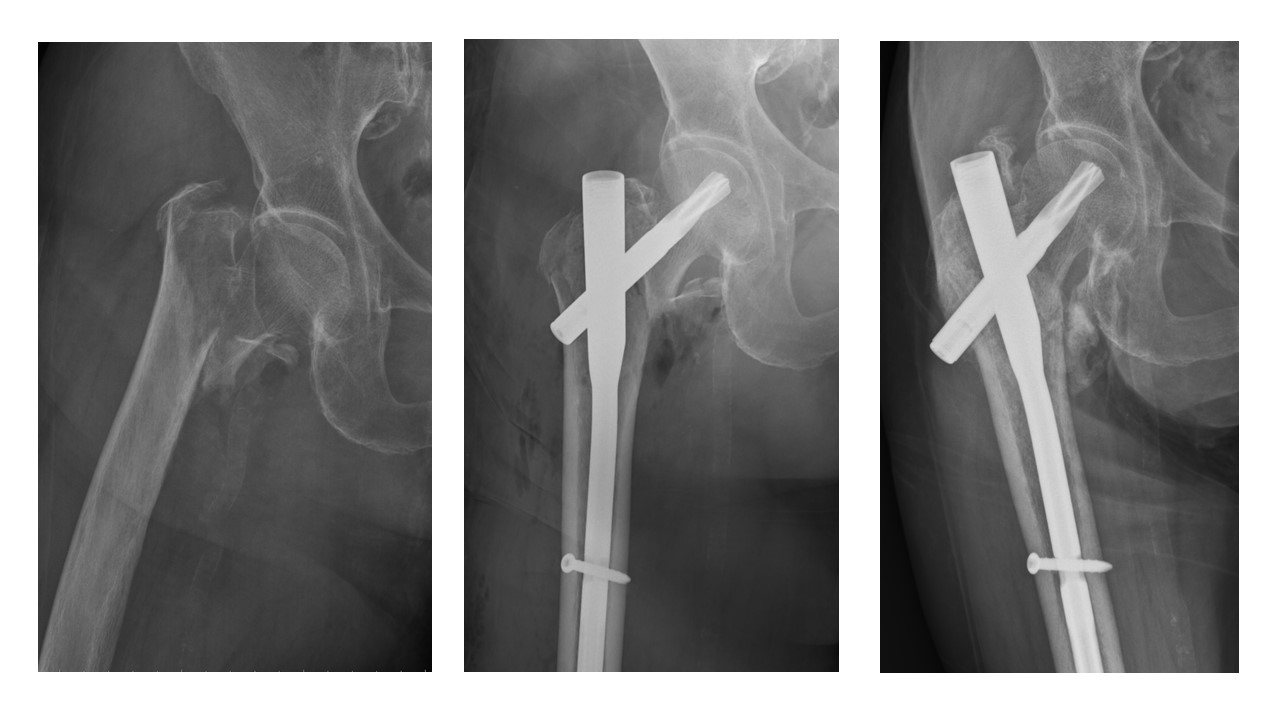
儘管有上述的種種好處,到目前為止仍沒有任何研究能強力證實髓內釘確實可取代髓外固定器治療轉子間骨折(6-8)。其原因除了骨折型態及內固定器的多樣性化,人為因素也相當重要。2015 年Niu 等人在 Clin Orthop Relat Res. 便提出不同時期及不同等級的醫院,對於轉子間骨折固定的訓練有所不同(9)。術者的個人技術經驗及偏好自然會影響術後結果。由於筆者身處醫學中心,在住院醫師訓練時期仍徧重髓外固定,在總醫師晚期才開始大量使用髓內釘。甫接觸髓內釘時,只覺得固定轉子間骨折變得十分簡單,用fracture table 將length 和rotation 固定住後,找到正確的entry point 和implant size,塞進去髓腔內,約莫半小時便可接下一台刀。然而隨著經驗增加,才知「代誌絕對不是憨人想的這樣簡單」,如惡夢般的併發症慢慢出現在眼前。
術後的malalignment 常肇因於以下幾種情形的mechanical failure,包括復位不良(如varus deformity、 shortening)、inadequate fixation、lag screw/blade cutout 和periprosthetic fracture 等(10)。如圖2 的病人屬於reverse obliquity type,在nail entry 較為外側的情況下,造成lateral cortex gapping 及varus malalignment,導致delayed union。
Cutout 亦常是轉子間骨折術後的夢魘,其可能原因很多,如病人年紀、骨質、配合度、骨折型態、術中復位好壞、固定物的選擇及lag screw/blade 的位置等。 unstable pattern 本身便容易伴隨不易復位及正確置放lag screw 難度高,增加了術後cutout 的機會(如圖3)。
上述因子除了病人本身的問題外,往往和術者的技術與經驗息息相關。若能將骨折良好復位,unstable fracture並不一定需仰賴髓內釘(如圖4);反之髓內釘若沒有適當的復位及固定,其結果也不見得較髓外固定為佳。且不論時代科技之演進及植入物孰優孰劣,處理骨折的中心思想:anatomic reduction、adequate fixation、early range of motion 仍是至今不變的治療原則。
Reference
1. Anglen JO, Weinstein JN, American Board of Orthopaedic Surgery Research C. Nail or plate fixation of intertrochanteric hip fractures: changing pattern of practice. A review of the American Board of Orthopaedic Surgery Database. J Bone Joint Surg Am. 2008;90(4):700-7.
2. Rosenblum SF, Zuckerman JD, Kummer FJ, Tam BS. A biomechanical evaluation of the Gamma nail. J Bone Joint Surg Br. 1992;74(3):352-7.
3. Sadowski C, Lubbeke A, Saudan M, Riand N, Stern R, Hoffmeyer P. Treatment of reverse oblique and transverse intertrochanteric fractures with use of an intramedullary nail or a 95 degrees screw-plate: a prospective, randomized study. J Bone Joint Surg Am. 2002;84-A(3):372-81.
4. Utrilla AL, Reig JS, Munoz FM, Tufanisco CB. Trochanteric gamma nail and compression hip screw for trochanteric fractures: a randomized, prospective, comparative study in 210 elderly patients with a new design of the gamma nail. J Orthop Trauma. 2005;19(4):229-33.
5. Platzer P, Thalhammer G, Wozasek GE, Vecsei V. Femoral shortening after surgical treatment of trochanteric fractures in nongeriatric patients. J Trauma. 2008;64(4):982-9.
6. Barton TM, Gleeson R, Topliss C, Greenwood R, Harries WJ, Chesser TJ. A comparison of the long gamma nail with the sliding hip screw for the treatment of AO/OTA 31-A2 fractures of the proximal part of the femur: a prospective randomized trial. J Bone Joint Surg Am. 2010;92(4):792-8.
7. Bohl DD, Basques BA, Golinvaux NS, Miller CP, Baumgaertner MR, Grauer JN. Extramedullary compared with intramedullary implants for intertrochanteric hip fractures: thirty-day outcomes of 4432 procedures from the ACS NSQIP database. J Bone Joint Surg Am. 2014;96(22):1871-7.
8. Swart E, Makhni EC, Macaulay W, Rosenwasser MP, Bozic KJ. Cost-effectiveness analysis of fixation options for intertrochanteric hip fractures. J Bone Joint Surg Am. 2014;96(19):1612-20.
9. Niu E, Yang A, Harris AH, Bishop J. Which Fixation Device is Preferred for Surgical Treatment of Intertrochanteric Hip Fractures in the United States? A Survey of Orthopaedic Surgeons. Clin Orthop Relat Res. 2015;473(11):3647-55.
10. Mavrogenis AF, Panagopoulos GN, Megaloikonomos PD, Igoumenou VG, Galanopoulos I, Vottis CT, et al. Complications After Hip Nailing for Fractures. Orthopedics. 2016;39(1):e108-16.
隨著老年社會的到來,骨質疏鬆的病人與日俱增,髖部骨折幾已成為日常的骨科境況。其中轉子間不穩定型骨折(unstable intertrochanter fracture)的固定,對於許多骨科醫師而言,仍是棘手的臨床課題。由於內固定器的發展, (intertrochanter fracture 的固定從早期使用髓外固定器(extramedullary fixation)(如blade-plate, sliding hip-screw, and locking-plate fixation 等)已逐漸偏向採用髓內固定器(intramedullary fixation)。JBJSA 在2008年的文章就指出美國intramedullary fixation 的使用率從1999 年的3% 一路攀升到2006 年的67%(1)。這種情況在筆者所處的高醫體系亦可見一斑。然而這樣的大勢所趨是醫療科技進步使然? 還是廠商、醫院、甚至政策的相互影響所促成? 筆者嘗試單純就臨床分析髓內釘治療轉子間不穩定型骨折的優劣,以期提供骨科同好們日後選擇的參考。
髓內釘應用在intertrochanter fracture 的生物力學優勢包括能有效地將femoral head 的承重轉移至medial calcar、其髓內的解剖位置因較為接近mechanical axis,能減少骨折移位的力矩和應變量(2)。手術過程中相較於髓外固定能減少軟組織的破壞(3),亦有文獻指出可減少手術時間、輸血需求、住院天數、術後腿不等長的風險、及較佳的術後活動能力(4, 5)。更重要的是面對不穩定的骨折型態,如compromise of the posteromedial or the lateral cortex、subtrochanteric extension 和reversed obliquity 等情況時能提供較可信賴的固定效果(1, 3-5)(如圖1)。
圖1

儘管有上述的種種好處,到目前為止仍沒有任何研究能強力證實髓內釘確實可取代髓外固定器治療轉子間骨折(6-8)。其原因除了骨折型態及內固定器的多樣性化,人為因素也相當重要。2015 年Niu 等人在 Clin Orthop Relat Res. 便提出不同時期及不同等級的醫院,對於轉子間骨折固定的訓練有所不同(9)。術者的個人技術經驗及偏好自然會影響術後結果。由於筆者身處醫學中心,在住院醫師訓練時期仍徧重髓外固定,在總醫師晚期才開始大量使用髓內釘。甫接觸髓內釘時,只覺得固定轉子間骨折變得十分簡單,用fracture table 將length 和rotation 固定住後,找到正確的entry point 和implant size,塞進去髓腔內,約莫半小時便可接下一台刀。然而隨著經驗增加,才知「代誌絕對不是憨人想的這樣簡單」,如惡夢般的併發症慢慢出現在眼前。
術後的malalignment 常肇因於以下幾種情形的mechanical failure,包括復位不良(如varus deformity、 shortening)、inadequate fixation、lag screw/blade cutout 和periprosthetic fracture 等(10)。如圖2 的病人屬於reverse obliquity type,在nail entry 較為外側的情況下,造成lateral cortex gapping 及varus malalignment,導致delayed union。
圖2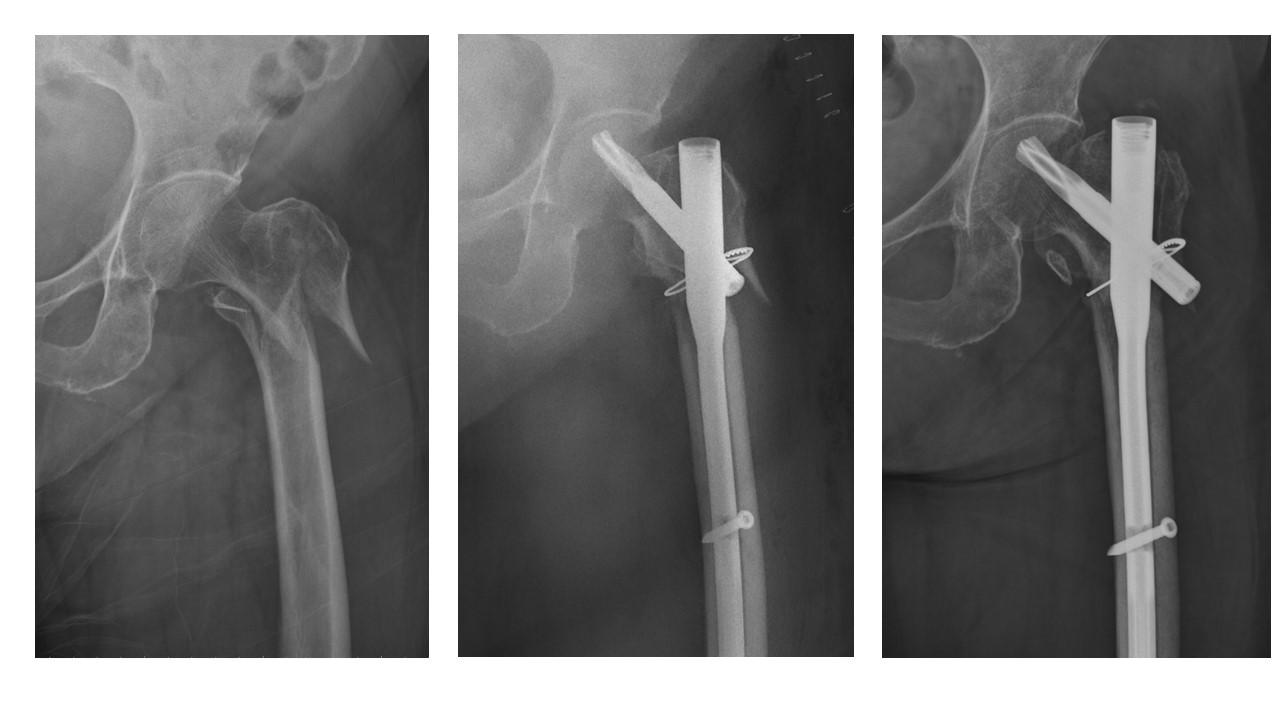

Cutout 亦常是轉子間骨折術後的夢魘,其可能原因很多,如病人年紀、骨質、配合度、骨折型態、術中復位好壞、固定物的選擇及lag screw/blade 的位置等。 unstable pattern 本身便容易伴隨不易復位及正確置放lag screw 難度高,增加了術後cutout 的機會(如圖3)。
圖3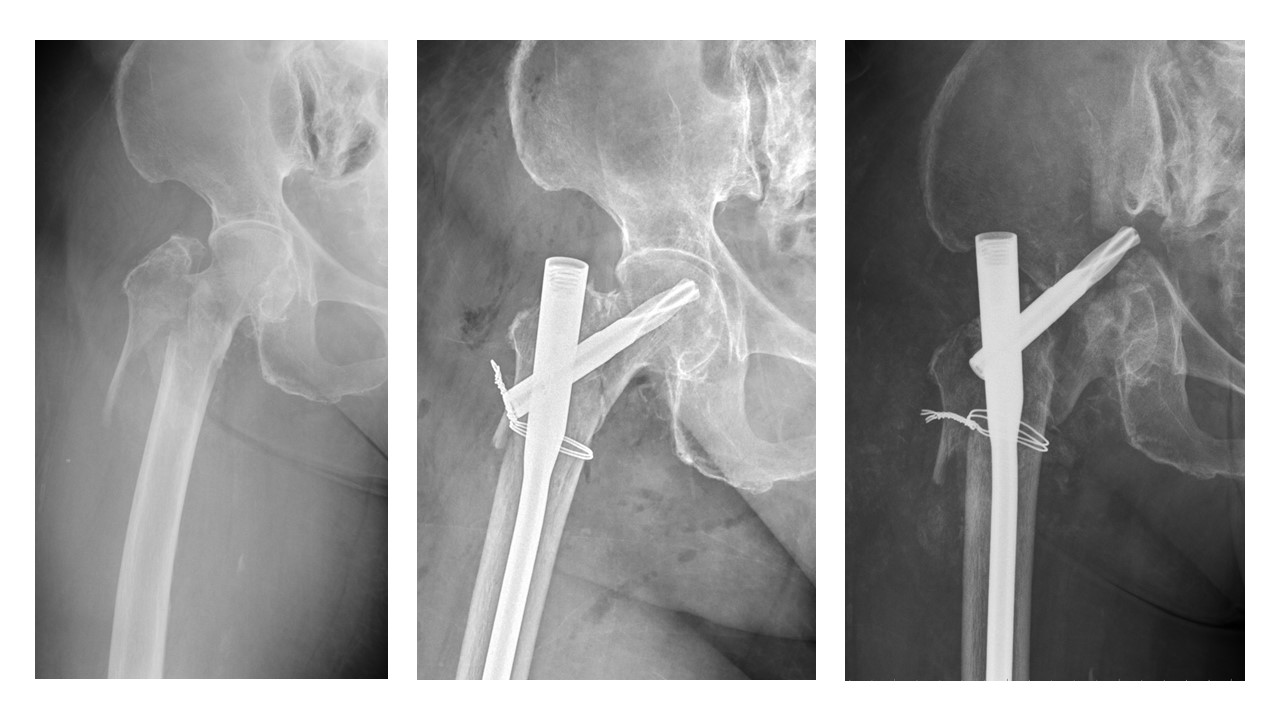

上述因子除了病人本身的問題外,往往和術者的技術與經驗息息相關。若能將骨折良好復位,unstable fracture並不一定需仰賴髓內釘(如圖4);反之髓內釘若沒有適當的復位及固定,其結果也不見得較髓外固定為佳。且不論時代科技之演進及植入物孰優孰劣,處理骨折的中心思想:anatomic reduction、adequate fixation、early range of motion 仍是至今不變的治療原則。
圖4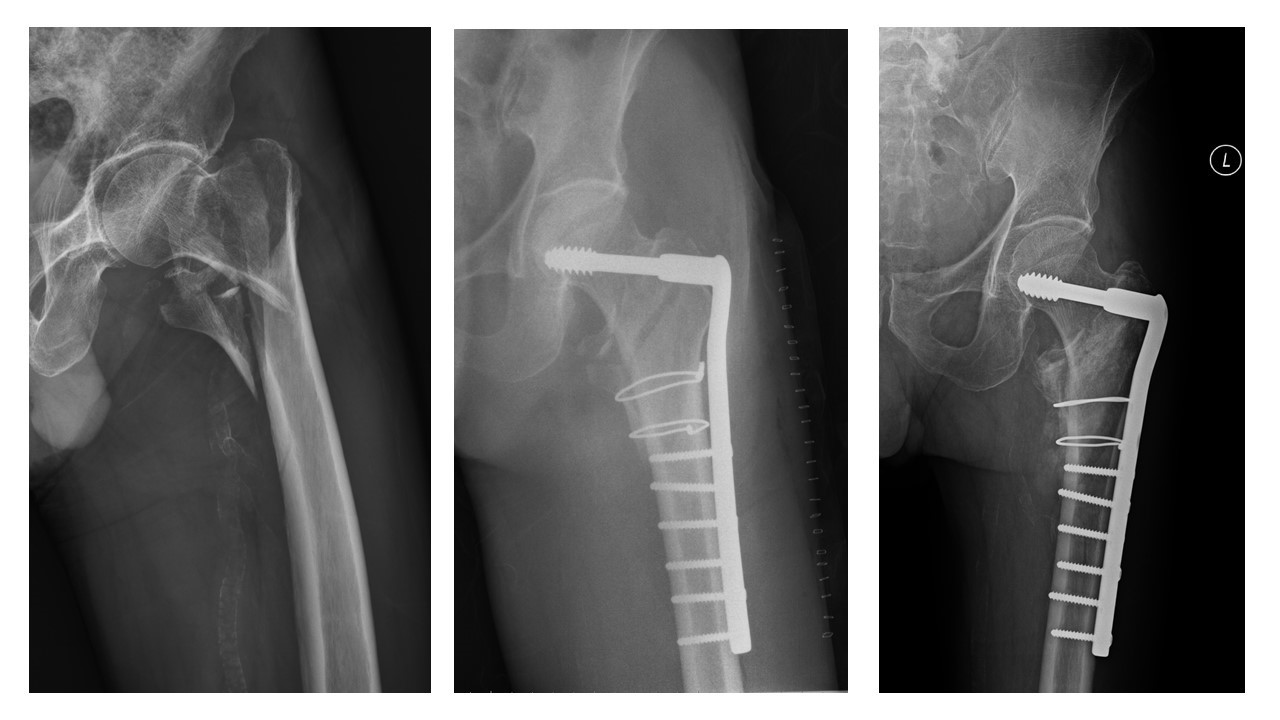

Reference
1. Anglen JO, Weinstein JN, American Board of Orthopaedic Surgery Research C. Nail or plate fixation of intertrochanteric hip fractures: changing pattern of practice. A review of the American Board of Orthopaedic Surgery Database. J Bone Joint Surg Am. 2008;90(4):700-7.
2. Rosenblum SF, Zuckerman JD, Kummer FJ, Tam BS. A biomechanical evaluation of the Gamma nail. J Bone Joint Surg Br. 1992;74(3):352-7.
3. Sadowski C, Lubbeke A, Saudan M, Riand N, Stern R, Hoffmeyer P. Treatment of reverse oblique and transverse intertrochanteric fractures with use of an intramedullary nail or a 95 degrees screw-plate: a prospective, randomized study. J Bone Joint Surg Am. 2002;84-A(3):372-81.
4. Utrilla AL, Reig JS, Munoz FM, Tufanisco CB. Trochanteric gamma nail and compression hip screw for trochanteric fractures: a randomized, prospective, comparative study in 210 elderly patients with a new design of the gamma nail. J Orthop Trauma. 2005;19(4):229-33.
5. Platzer P, Thalhammer G, Wozasek GE, Vecsei V. Femoral shortening after surgical treatment of trochanteric fractures in nongeriatric patients. J Trauma. 2008;64(4):982-9.
6. Barton TM, Gleeson R, Topliss C, Greenwood R, Harries WJ, Chesser TJ. A comparison of the long gamma nail with the sliding hip screw for the treatment of AO/OTA 31-A2 fractures of the proximal part of the femur: a prospective randomized trial. J Bone Joint Surg Am. 2010;92(4):792-8.
7. Bohl DD, Basques BA, Golinvaux NS, Miller CP, Baumgaertner MR, Grauer JN. Extramedullary compared with intramedullary implants for intertrochanteric hip fractures: thirty-day outcomes of 4432 procedures from the ACS NSQIP database. J Bone Joint Surg Am. 2014;96(22):1871-7.
8. Swart E, Makhni EC, Macaulay W, Rosenwasser MP, Bozic KJ. Cost-effectiveness analysis of fixation options for intertrochanteric hip fractures. J Bone Joint Surg Am. 2014;96(19):1612-20.
9. Niu E, Yang A, Harris AH, Bishop J. Which Fixation Device is Preferred for Surgical Treatment of Intertrochanteric Hip Fractures in the United States? A Survey of Orthopaedic Surgeons. Clin Orthop Relat Res. 2015;473(11):3647-55.
10. Mavrogenis AF, Panagopoulos GN, Megaloikonomos PD, Igoumenou VG, Galanopoulos I, Vottis CT, et al. Complications After Hip Nailing for Fractures. Orthopedics. 2016;39(1):e108-16.

